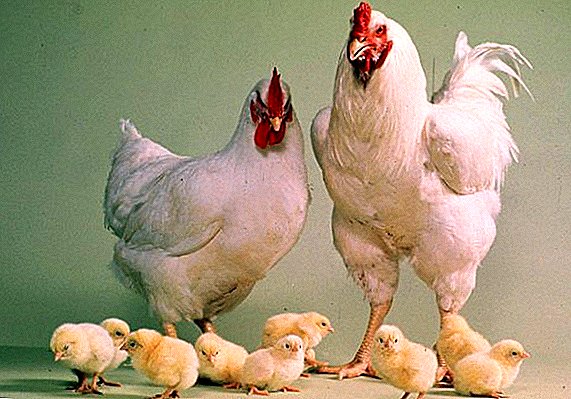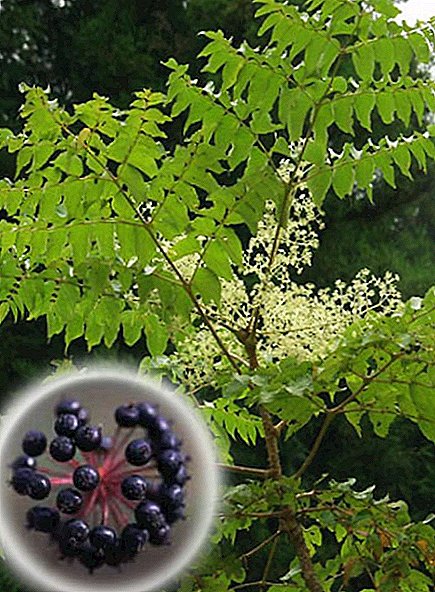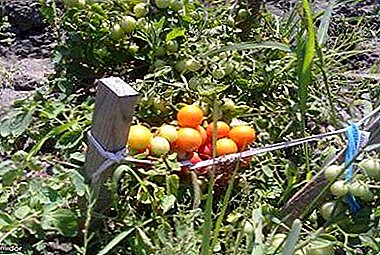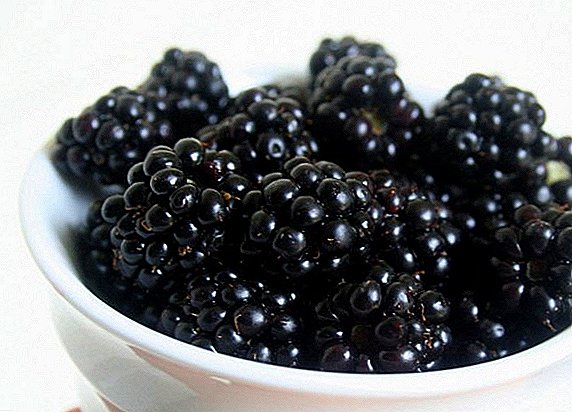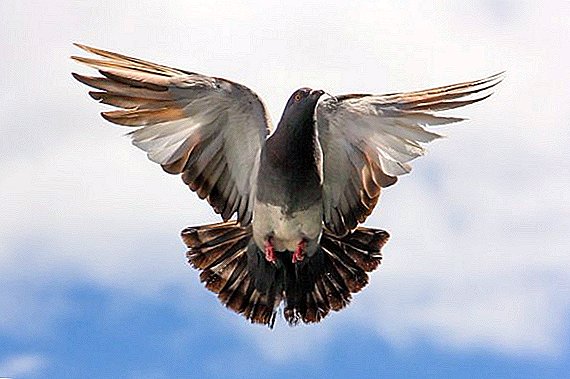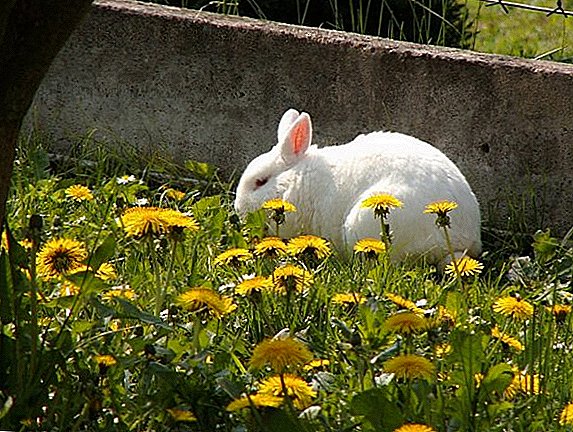 Honeysuckle is not only a very tasty berry, but also of great benefit to the human body. In this article we will talk about how to choose the right plant, based on the characteristics of the shrub and its taste. And also consider the best varieties of edible honeysuckle with their description.
Honeysuckle is not only a very tasty berry, but also of great benefit to the human body. In this article we will talk about how to choose the right plant, based on the characteristics of the shrub and its taste. And also consider the best varieties of edible honeysuckle with their description.
Did you know? There are about 250 species of honeysuckle. Most of them are inedible. The most famous is the wolfberry.
The best varieties of honeysuckle: how to choose a plant for garden height
 Honeysuckle can grow up to 5 m in height. Quite often it is used as a hedge in landscape design. The choice of a bush depends on what your goals are. If you need a fruiting shrub, then high honeysuckle varieties are best for this purpose. If not, you can choose undersized varieties.
Honeysuckle can grow up to 5 m in height. Quite often it is used as a hedge in landscape design. The choice of a bush depends on what your goals are. If you need a fruiting shrub, then high honeysuckle varieties are best for this purpose. If not, you can choose undersized varieties.
To create a garden landscape, you can use such hedges as the western thuja "Brabant", common privet, fieldfare, kobey, cotoneaster, piedleaf, hazelnut, barberry and maple.
Undersized honeysuckle
Low-growing honeysuckle reach 1-1.5 meters in height. These include varieties such as:
- Nizhny Novgorod early. It grows up to 1 m, has a dense crown. Pear-shaped berries. Ripens earlier than other varieties.
- Lulia It grows to 1.4 m, has a rounded shape. Berries are cylindrical with a spout at the top. Used for desserts and homemade processing.
- Gourmand. It grows to 1.4 m, has a small oval top. Berries of medium size, elongated shape. Used fresh and for home processing.
- Violet. It grows to 1.3 m, with an oval crown. Berries with a pointed elongated top. Good for desserts.
- Ramenskaya. It grows up to 1.4 m. The berries are medium, oval-shaped. Suitable for dessert use.
- Yuliya. It grows up to 1.1 m, with a small spherical shape. Barrel shaped berries with a flat top. Used for desserts and for decorative purposes.
- Souvenir. It grows up to 1.5 m, with a thick crown. Berries are small, cylindrical in shape.
- Kamchadalka. It grows up to 1.5 m, with a sparse conical crown. Berries oval. Suitable for desserts.
- Gzhel late. It grows up to 1.5 m, with an oval-shaped crown. The berries are quite large, suitable for desserts.



Medium variety
Can grow from 1.5 to 2 meters in height. For example:
- Gzhelka. Height - 1.7 meters. The fruits are curved, in the shape of a pod, of medium size. Used for desserts and for decorative purposes.
- Gzhel early. Height - 2 meters. Fruits with a flat top, large size, suitable for desserts.
- Kubyshka. Height - 1.8 meters, sprawling. Fruits are very large with a flat wide top. Universal in use.
- Kingfisher. Height - 2 meters, with a narrow crown. Fruits are large, shaped like a pear. Used in desserts and decorative purposes.
- Kuminovka. Height - 2 meters. Fruits are large, elongated, cylindrical in shape. Used for homemade processing and desserts.
- Korchaga Height - 1.7 meters with a narrow crown. The fruits are pitcher-shaped. Good for diet food.
- Princess Diana. Height - 1.9 meters with an oval-shaped crown. Cylindrical fruit. Suitable for desserts.
- The pile is small. Height - 1.8 meters. The fruits are large and long. Suitable for desserts and processing.
- My joy. Height - 1.6 meters with an oval-shaped crown. Fruits are medium with a wide flat top. Suitable for desserts and processing.
- Shahinya Height - 1.8 meters. Large sized fruits with a flat top. Used for desserts and for decorative purposes.
- Cinderella. Height - 1.6 meters with a round top. Fruits are oval. Universal in use.
- Bakcharskaya. Height - 1.6 meters, round crown. Fruits are average drop-shaped. Suitable for desserts, processing and for decorative purposes.
Important! Honeysuckle berries have been used in medicine for a very long time. They contain vitamins of groups B, C, P, A, fructose and glucose. They are used as a tonic and refreshing agent for diseases of the heart, liver and gallbladder. And also to lower blood pressure.



High varieties of honeysuckle
Did you know? The largest is the Bakcharskaya variety or, as it is also called, the Giant variety. Bushes reach about 2 m in height and about 1.3 m in width. The berries are very large, up to 5 cm, asymmetrically elongated. Due to the gentle sweet and sour taste, universal in use.May have 2 meters or more in height. For example:
- Wiliga Berries are large with a rough surface. Used for desserts.
- Moscow 23. Fruits are large with an elongated spout. Universal in use.
- Fortune. The berries are large in size and resemble a pear. Suitable for desserts, used in landscaping.
- Nymph. The fruits are very large, curved. Universal in use.
- Volkhov. Medium-sized fruits with a blunt tip. Universal in use.



How to choose honeysuckle variety to taste
An important factor in choosing a plant variety is directly the taste of the berries. It has its own variety from sweet and sour to flavors with bitterness and various flavors. Consider the most common ones.
Did you know? Edible varieties of honeysuckle fruit are blue and black. Inedible - red and orange.
Sweet sour
 Treat sweet varieties of honeysuckle: Azure, Ramenskaya, Kingfisher. They ripen before others, but can quickly crumble.
Treat sweet varieties of honeysuckle: Azure, Ramenskaya, Kingfisher. They ripen before others, but can quickly crumble.
Sweet with fine sourness
For those who prefer sweet taste with fine sourness, suitable: Gzhel early, Gzhel late, Nizhny Novgorod early, A lot of small, Princess Diana, Julia, Korchaga, Tomichka, Kamchadalka, Kuminovka, Bakcharskaya. Ripen a little later than sweet, but have a higher degree of yield.
Berries such as blueberries, viburnum, ezemalina, barberry, blueberry, black chokeberry, yoshta, cornel, gooseberry, juniper, prince, cloudberry and blackberry are a huge mine of vitamins for your body.
Sweet with pronounced sourness
 For lovers of pronounced sourness well suited: Gzhelka, Lyulia, Gerda, Wiliga, My Joy, Moskovskaya 23, Nymph, Omega, Violet, Souvenir, Kubishka, Ulyana, Blue Spindle, Gourmet, Sahin, Fortuna. Resistant to frost and practically not showered.
For lovers of pronounced sourness well suited: Gzhelka, Lyulia, Gerda, Wiliga, My Joy, Moskovskaya 23, Nymph, Omega, Violet, Souvenir, Kubishka, Ulyana, Blue Spindle, Gourmet, Sahin, Fortuna. Resistant to frost and practically not showered.
Sweet with strawberry shade
 There are also varieties of honeysuckle having strawberry shade: Volkhov and Cinderella. The disadvantages of this variety can be called shedding and not simultaneous ripening of fruits.
There are also varieties of honeysuckle having strawberry shade: Volkhov and Cinderella. The disadvantages of this variety can be called shedding and not simultaneous ripening of fruits.
How to get a big harvest of honeysuckle: description and photo of the most productive varieties
The plant is undemanding and tolerates frost well, needs abundant watering and obligatory shallow loosening of the soil. Honeysuckle roots are located closer to the surface. Pruning the bush after planting is possible only after two years.
Important! Honeysuckle is pollinated by insects. But there are self-infertile species. For their pollination must be the presence of other varieties on your site.Also, the honeysuckle harvest at the site depends on the plant variety you have chosen. The most fruitful are:
- Cinderella. Up to 3 kg yield.
- Wiliga Up to 2.5 kg yield.
- Gourmand. Up to 3 kg yield.
- Shahinya More than 2 kg of crop.
- Souvenir. Up to 2 kg yield.
- Kamchadalka. Up to 3 kg yield.
- Kuminovka. Up to 2 kg yield.
- Moscow - 23. Up to 4 kg of crop.



It is important to remember that proper care will help you get a bountiful and good harvest on your site. And the choice according to climatic conditions guarantees good growth and health to your plants.


